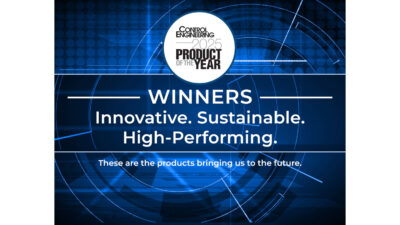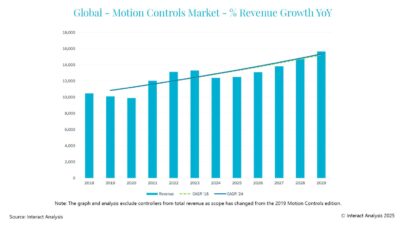T his year’s Hannover Fair offers visitors an integrated combination of six exhibition sectors. Besides the core Factory Automation sector covered in some detail in the main article, here is a further look at the other exhibit sectors available to control engineering practitioners during this March 20-25 event.
Other fair sectors
Materials Handling & Logistics (Halls 19-26 and open-air site) is the second largest show sector in terms of display area. In fact, its technologies overlap somewhat with factory automation. ‘These two trade fairs provide a complete picture of the manufacturing process-from production and assembly to logistics and warehousing,’ says Deutsche Messe AG (DMAG), organizer of Hannover Fair.
Two special presentations will accompany the exhibits. One display, called ‘Mobility 21,’ will highlight the integration and management of transport systems, as well as associated fleet management problems. A second presentation, ‘Logistics Networks,’ will display various fully integrated logistical networks.
Associated with the Energy sector exhibits (Halls 6-8) will be three conferences featuring closely related themes. At a so-called energy summit (March 22), industry experts will debate the topic of ‘Getting out of nuclear power: Where do we go from here?’ Hydrogen Technology will be one potential alternative explored in a following conference (March 23). A third presentation will examine the topic of Wind Energy . These technologies appear to be drawing increased attention worldwide.
Germany in particular claims several advances in applying energy technologies. Examples include the most energy-efficient coal-fired power plant in the world, the world’s largest gas-powered cogeneration (power and heat) plant, and wind power installations of the highest efficiency.
SubconTechnology (Halls 2-4), the forum for all aspects of subcontracting, will have a notable international presence that reflects the global nature of today’s component suppliers. Among trends in this sector, DMAG sees the selection of component manufacturers and the right materials as ‘increasingly important factors in business calculations.’ Greater responsibility for design and construction is being placed on component manufacturers. They ‘are now expected to supply subsystems and complete solutions,’ says DMAG.
Underscoring the crucial role of materials technologies, several forums and special presentations will be held. A special ‘Materials Forum’ with presentations and discussions by materials experts will be ongoing throughout the fair in Hall 4. This hall will also be the venue for ‘Trends in Aluminum’ and the ‘Plastics Engineering Center.’ Two important materials technologies- Casting and Forging -will be featured in separate presentations in Hall 3.
Surface Treatment (Halls 5-6) addresses numerous industrial processes comprising surface protection of products. Included here are surface cleaning and pretreatment methods as well as paints, enamels, electroplating, thin films, and plastics. Equipment to measure, test, and analyze surface treatment processes will also be on display.
Environmental protection and energy conservation aspects of surface treatment for products and manufacturing plants are the broader outlook of this sector’s 215,000-ft Galvanoland, Plasmaworld, and Thin-Layer Treatments.
Exhibits of Research & Technology (Hall 18)-also known as the ‘Innovations Market’-brings together exhibitors, visitors, and the scientific community. Participants include numerous research institutes, universities, and high-tech companies from around the world. Understandably, German firms have substantial share within this arena. ‘This is where scientific solutions with a practical application find their way directly into the marketplace,’ says DMAG. Transfer of research technologies to business and industry is the primary goal of this show sector. A ‘tech transfer’ initiative started at the 1998 fair seeks to speed up the time to market for these research innovations. Technology transfer experts will be on hand to advise visitors and answer their questions.
Special joint presentations and displays by several companies will likewise be in vogue here; example themes include Nanoworld and Microsystems Technology. Indicating its potential as a future energy source, ‘hydrogen and fuel cells’ will draw the attention of 13 international companies in this hall, along with eight others presenting products and services in the Energy sector (Hall 8).
Some things do change There will be no ‘partner country’ for Hannover Fair 2000. This breaks with a fair tradition to select a country each year to profile its industrial capabilities and business infrastructure. The honor includes exhibiting in its own Country Pavilion at the fair. In year 2000, space constraints and the ‘crush’ of the upcoming Expo 2000 has eliminated this practice.
Last year Chile was selected as the partner country. Some previous honorees include the Republic of the Philippines (1998), Britain (`97), the USA (`96), and Hungary (`94). Selection of Britain coincided with the fair’s milestone 50thanniversary that carried great historical significance relative to the founding of the fair (see CE , March 1997, pp. 103-104).
According to Deutsche Messe AG, no partner country is planned for next year’s fair. At this point, the future of this tradition remains in doubt.
U.S. companies
As explained in the main article , American companies have a substantial presence at Hannover Fair. However, many have local divisions and subsidiaries that manage the exhibit booths. The following is a short list of ‘independent’ U.S. exhibitors (or companies based in the U.S.) offering technologies closest to the interests of the control engineering audience.
Company
Location
Technology Areas
Advanced DC Motors
Syracuse, N.Y.
DC motors for electric vehicles
Afcon Control & Automation
Schaumburg, Ill.
Software for SCADA, process control, and data acquisition
Ametek
Kent, O.
Brushless motors and blowers
Appleton Electric
Skokie, Ill.
Industrial electrical products
Baldor Electric
Fort Smith, Ark.
Motors, drives, and motion control (MD&MC)
Dynapro
Milwaukee, Wis.
Industrial computers, touchscreens
Harmonic Drive Technologies (Teijin Seiki)
Peabody, Mass.
Precision gear systems, servo actuators
Hoffman
Anoka, Minn.
Electronic enclosures
Kollmorgen
Radford, Va.
MD&MC
Pacific Scientific
Wilmington, Mass.
MD&MC
PC Soft International
Mansfield, Mass.
Software and information integration
Phenix Technologies
Accident, Md.
High voltage/current/power test systems and components
PPT Vision
Eden Prairie, Minn.
Machine vision systems
Red Lion Controls
York, Pa.
Process measurement and control, HMI, signal conditioning, etc.
Expo 2000
The first World Exposition to be held in Germany from June 1 to October 31-Expo 2000-will also take place on these fairgrounds and an adjoining site built specially for this event. (For purists, a ‘world’s fair’ was scheduled for Berlin in 1896, but conflicts of interests and other international rules delegated that event to the category of an ‘industrial fair.’)
Visitors to Hannover Fair will be able preview some structures built for Expo 2000; for example the Expo Roof built between Halls 12 and 26. This 72,000-ftfairgrounds as well as around the city has been part of long-term projects.
While there is no firm connection between these two year 2000 events, the scope of Hannover Fair is very much in tune with the theme of Expo 2000-‘Humankind, Nature, Technology.’ Expo 2000 will host more nations than any previous world exposition. Nearly 200 nations and international organizations will ‘introduce their culture and visions for the future in pavilions and exhibition halls,’ says the Expo’s organizer. ‘Pavilions made of paper, wood or other natural materials turn Expo 2000 into a display of environmentally friendly architectural achievements.’
Organizations participating include ASEAN (Association of South East Asian Nations), CariCom (Caribbean Community), EU (European Community), UN (United Nations), and the World Bank.
Objective of Expo 2000 is to find common paths towards sustainable future life on this planet. Its central theme is based on a UN action program called Agenda 21. Described in a 500-page document, this ‘urgent call to tackle hunger and environmental destruction’ is estimated to cost $600 billion. Agenda 21 was declared by the heads of government of 179 countries at the 1992 Earth Summit in Rio de Janeiro, Brazil.
Experts from around the world will converge on Hannover to discuss key agenda topics in a series of special events entitled ‘Global Dialogue.’ Each of these three-day dialogues will offer scientists, politicians, project organizers, and decision-makers a platform to communicate their expertise. ‘The point is to develop realistic scenarios for a sustainable future,’ according to the Expo organizers. Worldwide media coverage and multimedia presentations will keep visitors updated on developments. ‘A final Global Dialogue will sum up the highlights and formulate visions of how humankind can meet the challenges of the 21st century.’
Far from being an event that addresses solely serious issues, a rich cultural program will complement Expo 2000’s activities. Advertised highlights are the mosaic of cultures to be found in the pavilions of participating nations, along with entertainment and gourmet sites.
For more information, visit www.hfusa.com (USA) or www.messe.de (Germany) or www.expo2000.de.
Comments? E-mail [email protected]



